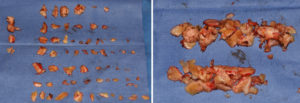Background: The ribcage is formed by a collection of twelve (12) ribs of various lengths, locations and compositions. The first seven (7) ribs are called the true ribs because they run between the spine to the sternum through a direct curvilinear connection. Ribs #s 8, 9 and 10 are called the false ribs because they are indirectly connected to the sternum through long curved cartilaginous connections to the seventh rib. Lastly the floating ribs are #s 11 and 12 because they have no sternal connection at all.
Besides the midline sternum and the shape of the adjoining upper chest, the other distinguishing ribcage feature is that of the subcostal region. Everyone knows this ribcage area well because you can put your hand up under it and even move it a bit. This is formed by the cartilaginous connections of the false ribs as they come around and upward to connect to rib #7. It is somewhat mobile because of its cartilage composition and can create its own aesthetic issues if it is too prominent.
One potential cause of an acquired subcostal ribcage protrusion deformity is trauma. Like all ribs, with the exception of #s1, 11 and 12, there is a bone-cartilage junction. (costochondral junction) This junction can be prone to separation from trauma as it is the ‘weak’ link along the entire length of the rib. Such costochondral disruptions can create a change in the subcostal shape.



pneumothorax.
Highlights:
1) The ribcage is prone to traumatic deformities particularly at the costochondral junctions
2) Subcostal ribcage protrusions can be reduced through a direct incisional approach.
3) Cartilage shaving of subcostal protrusions is an effective contouring technique that avoids sharp edge demarcations.
Dr. Barry Eppley
Indianapolis, Indiana



